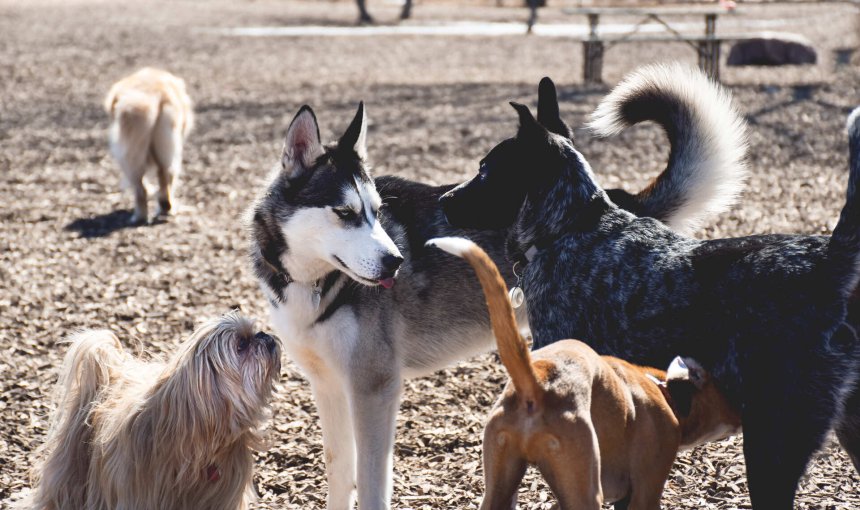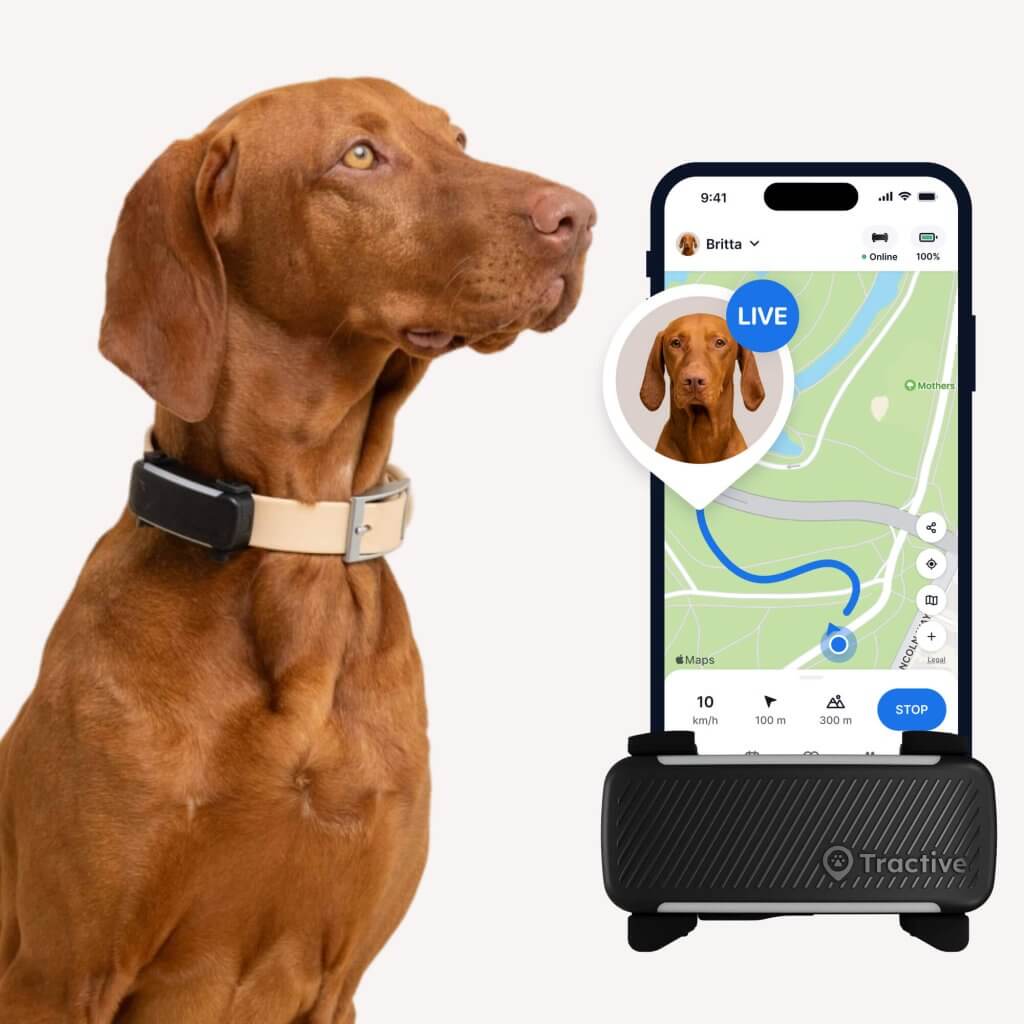Dog Park Etiquette: How To Take Your Dog To The Dog Park
Visiting a local dog park means your buddy gets to play, exercise and socialize with other pets & people. So here are some tips to help you get started with your visits - and how to keep your buddy safe throughout.

The freedom of running off-leash at the dog park might be a slice of heaven for your pup – or it might be their worst nightmare. And one of the main reasons why they might hide the next time you take them out to the park? They might not have nailed their dog park etiquette quite yet.
So here’s all the planning and prep you need to do before heading to your local dog park – and how to plan ahead for a “missing dog” situation in case your buddy gets spooked, startled, or up to some shenanigans. Let’s go!

Always know your buddy is healthy & safe
Read moreCheck your local dog park requirements, rules and fees
Before bringing your buddy to the local dog park, find out what’s required of you and your pup. Some parks are free, while others require a membership or one-time fee. Many parks require that your dog be licensed, collared, and vaccinated, too. That’s why we’d recommend you scope out the park in advance, without your dog at first.
- Are there separate areas for small and large dogs? Some parks feature obstacle courses, which are great for agility training.
- Is there a pond or pool for water play? (Great for hot summer days!)
- Is there a double gate to provide safe entry and exit?
- Does the park provide doggie waste bags and a disposal bin? Or do you need to bring your own bags and pack out waste?
Most parks post signs with rules. But the most important rule is that you are responsible for your dog and your dog’s behavior. Paying attention to your dog during the entire visit is the #1 rule of dog park etiquette.

Keep track of your dog’s daily adventures
Follow every step with unlimited range Live Tracking. Get alerts if they wander too far. Keep them happy & healthy with Activity & Sleep Monitoring. Get Health Alerts if something seems off.
Is your dog in the right condition to visit a park?
In general, it’s better to avoid visiting the dog park if your buddy is:
- Under 12 weeks old.
Small puppies are at risk of injuries and infections before they get all their shots. You may want to wait until they’re at least 18 weeks old before visiting a dog park. - In heat or pregnant.
The mating instinct is powerful and your girl dog might get some unwanted attention during this time. Do your best to keep them occupied at home. Your vet can also best advise you if getting her spayed is a good option. - Sick.
A sick dog is more likely to make other dogs sick – especially through airborne droplets, shared water bowls, and even skin to skin contact. - Sensitive to the weather.
Brachycephalic dog breeds – like Pugs, Boxers, and Bulldogs – may also be extra-sensitive to the warmth and more likely to overheat. So it’s best limiting their outdoors time when the sun’s out. Small dogs might not have enough body mass to retain heat in cold weather.
How to prep your buddy for a dog park visit
Refresh your dog’s basic training
Having a well-trained dog is the ultimate in dog park etiquette. When your dog is well trained, it means they trust you and have confidence in your leadership. So it’s always good to revisit basic obedience commands like “Sit,” “Stay,” and “Drop it” – all of which can come in handy when you’re both outdoors. If your dog is a little rusty on these basic commands, practice for a few weeks at home to reinforce the training before visiting the dog park. Once your dog is in the distracting environment of the dog park, your training will pay off and be a shining example of good dog park etiquette.
We’d also strongly recommend you train your dog to come when called (known as recall). If your dog reliably comes when called, you can avoid unpleasant situations like fights, bullying, and escapes at the dog park. As a bonus, you won’t need to play “catch me if you can” when it’s time to go home!
Monitor your dog’s body language
As your dog starts interacting with other pooches at the dog park, it’s a good idea to keep an eye out for whether everyone’s getting along. You can easily read a dog’s body language to determine if they are playful, upset, or angry. Here’s what to look for:
- Playful dogs spin around, bounce, and display a relaxed “play grin.” A “play bow” with the rump held high and front elbows on the ground is a good sign that a pooch is in a joyous mood during a dog play session!
- Anxious or upset dogs hold their tails low or between the legs and their ears may be pinned back. These dogs are feeling stressed or overwhelmed, so take them home and try visiting again on a less-busy day.
- Angry dogs are tense, with the head held high and ears pointing forward. They may snarl with the lips curled back. This dog is not displaying good dog park etiquette! Call your pup to your side and go home if you see this type of behavior in your dog or another pet.
Supervise your dog at all times
You may be tempted to scroll through social media or chat with other pet parents at the dog park. But instead, we’d highly recommend you pay attention to your dog at all times. Situations can change quickly during dog play, especially when the dog park is crowded with off-leash dogs of all sizes and temperaments. It’s also 100% okay for you to run and play with your dog at the park. Remember, interacting with you is your dog’s favorite thing to do!
What should I bring to a dog park?
Just like any outing, it’s important to plan ahead and bring the right gear for a successful dog park visit. We’d recommend you carry along:
- Water and a collapsible bowl so your buddy can stay hydrated. You’ll reduce the risk of your dog catching kennel cough or other diseases that can be transmitted at communal drinking facilities.
- Dog waste bags to pick up after your buddy after they do their business.
- Avoid bringing treats, toys, or food! You’ll attract the attention of all the dogs in the park, which can lead to some disagreements over who gets the treats. Rather, leave these at home or in your car and only offer them to your dog after you both leave.
How to ensure a safe dog park visit
On your first few visits to the dog park, plan to stay for a very short time. Stay just long enough to get a feel for your dog’s interest level, the other dogs in the park, and pick up on the park’s overall vibe. Once you become a regular at the park, you’ll find that 30- to 60-minute play sessions at the dog park are enough to tire out your dog.
Be respectful of other dogs & dog parents
Dogs of similar sizes and temperaments may play well together. Your dog may instantly run off to play with others, or you may need to formally introduce your dog to a new friend. Just make sure to check with other dog parents first to make sure they are okay with a doggie play date. Always ask before petting someone else’s dog. We’re not kidding – don’t skip this step! Not every dog (or dog parent) wants to be approached and some anxiety-prone dogs might bark or even bite if you touch them out of nowhere.
Also remember: barking is okay at the dog park. As long as your dog is playing with others (or with you) in a positive manner and is exhibiting good dog park etiquette, allow the play to continue.
Stop your dog from bullying other dogs
A bully is no fun to be around – for people or for dogs. Remove your dog from any situation where your dog (or other dogs) exhibits bullying behavior. Bullies may employ dominance behaviors such as placing their paws and head on the shoulders of other dogs, excessive mounting, or pinning other dogs to the ground. If your dog tends to be a bully, the dog park is not the place to teach them good dog park etiquette. Leave the dog park so you don’t put other people or dogs at risk. Work on basic obedience training at home or get help from a professional to get rid of any bullying behavior.
Remove an uncomfortable dog
Shy dogs may not enjoy the commotion of a dog park, and you’ll know it by their body language. Instead, shy dogs may benefit from socializing with one or two other dogs in the neighborhood for a few weeks before tackling the dog park. Avoid visiting during busy periods, like Sunday afternoons, if your dog needs a quiet introduction to the dog park. By watching your dog’s body language, you’ll know when they are ready to leave the dog park. If your dog comes to stand by your side or at the gate, they are giving you a not-so-subtle hint that they are ready to go home.
Watch out for any “danger zones” you come across
Depending on how close the dog park is to any crowded city areas or even woodland, you might come across some less-than-pleasant objects in your environment. Including areas with:
- Poisonous plants, including mushrooms, which can be toxic to dogs
- Animal traps, which can injure your dog if they get a paw stuck in it
- Poison bait, which can make your dog very sick if they bite or lick it
- Wild animals
- Sharp objects
- And anything else you’d rather not have your dog run into while outdoors
💡But if you’ve invested in a Tractive dog tracker, you can report a “danger” in your environment – which then gets broadcast to fellow pet parents in your area!

Just head to your Tractive mobile app and get sharing right away. So you can both keep your dog safe – and do your part as a responsible dog parent.
Ready to make the dog park your buddy’s favorite place?
Regularly dropping by your local dog park is a great way to help your buddy exercise and hang out with other dogs and people. All of which can help them learn to behave – and help others learn how to behave around them. So make sure you’re doubling down on their obedience training, keeping an eye on them throughout, and being respectful of other dogs and dog parents. This will ensure you two have a fun, safe dog park visit – every time.



